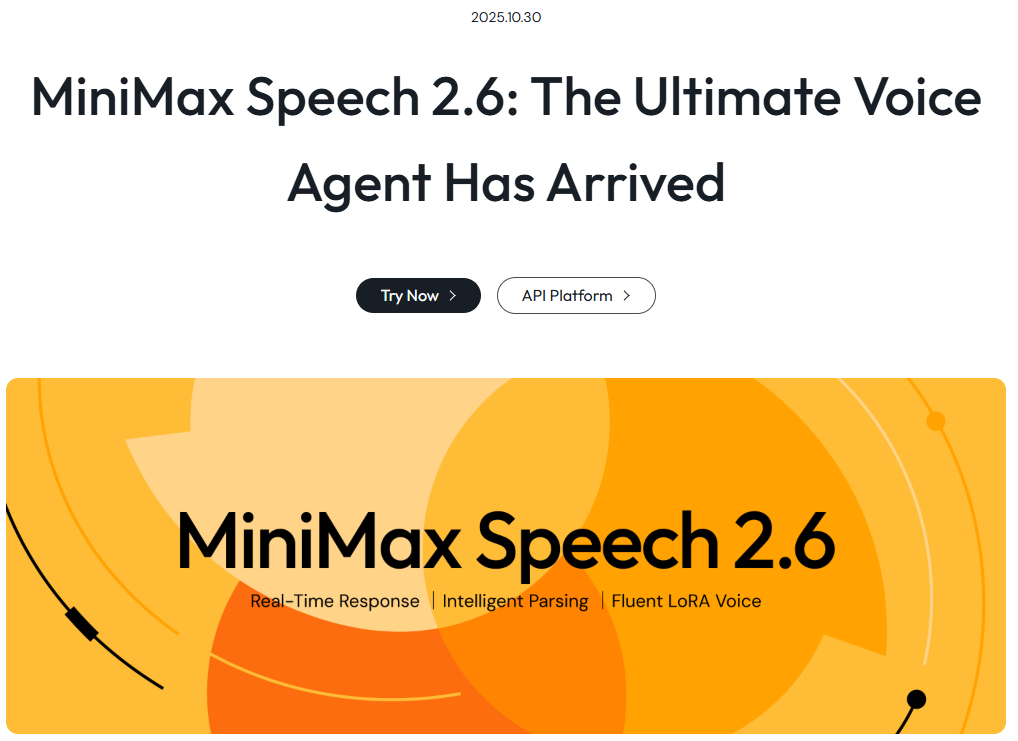The conversational AI landscape is being redefined by MiniMax Speech 2.6, which delivers both instant voice cloning and sub-250ms latency. This next-generation model moves beyond creating generic human-like voices to enabling personalized, real-time interactions.
Officially launched on October 30, MiniMax Speech 2.6 introduces two breakthrough technologies: an end-to-end latency under 250 milliseconds and revolutionary Fluent LoRA voice cloning.
This release solidifies MiniMax’s position in the competitive AIGC market, demonstrating that true intelligence lies in creating a compelling and customizable voice experience.
What is MiniMax Speech 2.6?
In the realm of real-time voice interaction, latency is the critical determinant of user experience. Even a slight, perceptible delay can disrupt the natural rhythm of a conversation, breed frustration, and erode user trust. MiniMax Speech 2.6 has been engineered from the ground up to tackle this fundamental challenge.

Through comprehensive optimization of its underlying architectural framework, Speech 2.6 accomplishes a remarkable feat: a complete end-to-end delay—spanning from the moment of text input to the generation of audio output—of less than 250 milliseconds. This speed closely mirrors the natural cadence of human-to-human dialogue, effectively eradicating the awkward pauses and “slow-to-respond” feeling that has long plagued legacy AI voice systems.
The implications of this ultra-low latency are transformative for a wide array of high-demand applications:
- Intelligent Customer Service: It enables AI agents to engage in fluid, real-time dialogue with customers, making interactions feel more like a natural conversation than a stilted Q&A session.
- Live Subtitling and Translation: The technology provides near-instantaneous conversion of speech to text or one language to another, crucial for live broadcasts, conferences, and real-time assistance.
- Virtual Anchors and Digital Humans: It allows for seamless and immersive interactions with digital entities, where the response is so immediate that it fosters a genuine sense of presence and natural engagement.
By ensuring the AI’s response is no longer “half a beat slow,” MiniMax Speech 2.6 lays the foundation for a significantly smoother, more engaging, and ultimately more trustworthy user experience across all interactive voice applications.
Fluent LoRA: Exclusive Voice Cloning with Just 30 Seconds of Audio
Perhaps the most striking innovation within MiniMax Speech 2.6 is the deep integration of its proprietary Fluent LoRA (Low-Rank Adaptation) technology. This feature fundamentally democratizes and refines the process of creating a bespoke digital voice, making it more accessible, efficient, and strikingly realistic than ever before.
The Power of Fluent LoRA includes:
- Minimal Input, Maximum Fidelity: The system requires only a short, 30-second audio sample of a target voice to begin the cloning process.
- Comprehensive Vocal Replication: The model goes beyond simple pitch matching. It meticulously analyzes and captures the speaker’s unique timbre, characteristic intonation, speech rhythm, and even the subtle nuances of their emotional delivery.
- High-Quality, Natural Output: The result is synthesized speech that is not only a convincing match to the target voice but also flows with the natural cadence and expressiveness of human speech.
This capability unlocks a vast spectrum of personalized applications. Imagine an author narrating an entire audiobook in their own voice after providing a single short sample, or a global corporation deploying a consistent, branded virtual spokesperson across all its customer touchpoints. The era of complex, data-intensive, and time-consuming voice cloning is effectively over.
Furthermore, Fluent LoRA addresses longstanding hurdles of traditional Text-to-Speech (TTS) systems. It does more than just clone; it enhances the overall fluency of the synthesized speech while rigorously maintaining voice consistency. This technology actively avoids common synthetic speech pitfalls, such as:
- The “robotic” and mechanical segmentation of sentences.
- Emotional misalignment where the tone does not match the content.
- Unnatural-sounding emphasis on certain words or syllables.
The outcome is synthetic audio that possesses genuine expressiveness, making it emotionally credible and highly persuasive for the listener.
Use Cases of MiniMax Speech 2.6
MiniMax Speech 2.6 is architected to deliver value across a diverse user base, from individual digital creators to large enterprise clients, offering transformative solutions in numerous sectors:
- Education Sector: Educators and instructional designers can rapidly generate high-quality, narrated audio for online courses, training modules, and educational content, drastically reducing production time and costs while maintaining a personal touch.
- Customer Service & Branding: Businesses can deploy intelligent voice bots that feature a unique, branded voice, strengthening brand identity and fostering a more memorable and consistent customer experience.
- Smart Hardware & IoT: Integration into in-car infotainment systems, smart home assistants, and other IoT devices enables ultra-low latency, highly realistic voice interaction, finally moving away from the jarring and robotic voices of the past.
- Content Production: Podcasters, video creators, and game developers can instantly generate multi-character voiceovers for their scripts, dramatically boosting creative output and production efficiency without the need for a full cast of voice actors.
- Accessibility & Personal IP: Individuals can create a secure digital version of their voice for use in assistive communication devices or to safeguard their vocal identity as a form of personal intellectual property.
Conclusion on MiniMax Speech 2.6
As a pivotal component of MiniMax’s multi-modal large model ecosystem, the launch of Speech 2.6 does more than just showcase the company’s technical prowess in the AIGC domain. It signals a pivotal industry transition, where speech synthesis is evolving from a stage of basic “functional usability” to one of “emotional credibility and customizable personalization.”
In an intensely competitive AI landscape where the focus is increasingly on the refinement of user experience, MiniMax Speech 2.6 delivers a powerful statement.
By achieving a barely perceptible 250-millisecond latency and offering the ability to create a voice that is authentically “you,” the company demonstrates that the essence of next-generation intelligence lies not merely in computational speed, but in the ability to communicate with the nuance, warmth, and persuasiveness of a real person. This dual mastery of speed and naturalness establishes a new, higher benchmark for the future of conversational AI.



